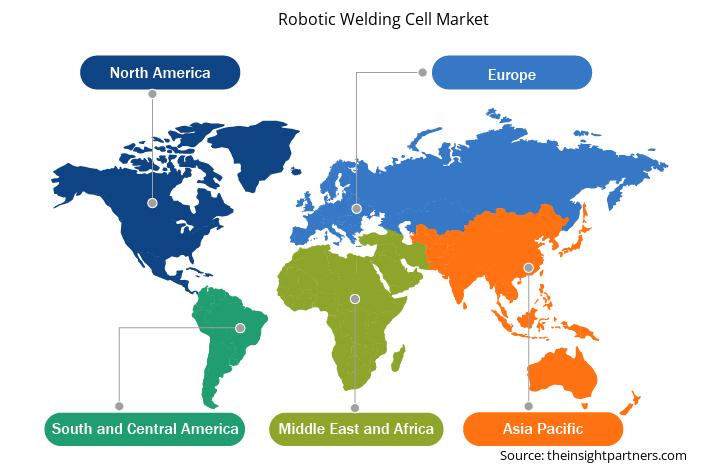ロボット溶接セルの市場規模は、2023年の15億1,115万米ドルから2031年には37億2,664万米ドルに達すると予測されています。市場は2023年から2031年の間に11.9%のCAGRを記録すると予想されています。インダストリー4.0テクノロジーの採用の増加により、今後数年間で市場に新たな主要トレンドがもたらされる可能性があります。
ロボット溶接セル市場分析
ロボット溶接セルは、部品を溶接するために連携して動作する複数のコンポーネントで構成されています。ロボット溶接セルは世界クラスの溶接作業を提供し、オペレーターのコストと時間を節約するために世界標準に従って設計されています。プレエンジニアリングセルはコスト効率の高いロボット溶接セルで、溶接プロセスに必要な基本的な必須コンポーネントのみが含まれています。このセルの基本構造はすぐにインストールできるため、メーカーはセルの製造時間を短縮し、最終製品をできるだけ早く納品できます。カスタムセルは、基本的な必須コンポーネントに加えて独自の機器が含まれているため、プレエンジニアリングセルに比べて高価です。これらは主にクライアントの特定の関心に合わせて製造されます。したがって、カスタムロボット溶接セルの製造と納品に必要な時間は、プレエンジニアリングセルよりも長くなります。溶接ロボットは自動車業界で広く使用されています。自動車の需要は著しく増加しています。消費者支出の増加は、特にアジア諸国で世界中の自動車の需要を牽引している要因の1つです。国際自動車工業会が2024年に発表したデータによると、2023年の自動車総生産台数は9,300万台に達し、2021年から2023年にかけて12%増加しました。新施設の建設の増加により、これらの新しい自動車施設での溶接ロボットの需要が増加し、最終的にロボット溶接セル市場を牽引しています。
ロボット溶接セル市場の概要
世界のロボット溶接セル市場エコシステムの主な利害関係者には、原材料/コンポーネントプロバイダー、ロボット溶接セルメーカー、政府機関、規制機関、および最終顧客が含まれます。コンポーネントおよびハードウェアプロバイダーは、ロボット溶接セルメーカーにさまざまなコンポーネントと部品を提供します。このレポートに含まれる主要なロボット溶接セルメーカーには、Abb Ltd、Acieta LLC、Carl Cloos Schweisstechnik Gmbh、川崎重工業株式会社、Kuka AG、Phoenix Industrial Solutions、The Lincoln Electric Company、Wec Group Ltd.、およびYaskawa America、Inc.などがあります。ロボット溶接セルメーカーの後に、世界のロボット溶接セル市場にはいくつかの周辺利害関係者がおり、ロボット溶接セルの技術的進歩と採用を可能にする上で重要な役割を果たしています。
要件に合わせてレポートをカスタマイズする
このレポートの一部、国レベルの分析、Excelデータパックなど、あらゆるレポートを無料でカスタマイズできます。また、スタートアップや大学向けのお得なオファーや割引もご利用いただけます。
- このレポートの主要な市場動向を入手してください。この無料サンプルには、市場動向から見積もりや予測に至るまでのデータ分析が含まれます。
ロボット溶接セル市場の推進要因と機会
製造業におけるロボット導入の増加
ロボットは製造業で重要な役割を果たしています。ロボットは、生産業務の全体的な効率と生産性の向上に役立ちます。製造業では、組み立てとディスペンシング、ハンドリングとピッキング、機械加工と切断、溶接とはんだ付け、鋳造と成形、仕上げとサンディング、塗装とコーティング、清掃と衛生、物流と保管、梱包とパレタイジングなど、さまざまな用途に使用されています。国際ロボット連盟が2024年に発表したデータによると、2023年には世界中の工場で約420万台のロボットが稼働しており、2022年の390万台から増加しています。国際ロボット連盟が2021年に述べたように、工場で稼働するロボットの半分は溶接用途に使用されます。したがって、製造業におけるロボットの採用の増加は、ロボット溶接セル市場の成長を推進しています。
レーザー溶接およびプラズマ溶接技術の採用増加
レーザー溶接の需要は急速に高まっています。レーザー溶接技術は、二酸化炭素、窒素、ヘリウムを使用して開発された高エネルギーレーザービームを使用します。これにより、材料を高精度かつ高速に接合できます。レーザー溶接は、歪みが最小限で、さまざまな材料を溶接できるため、人気が高まっています。さらに、レーザー効率を改善し、溶接プロセスを最適化することで、このタイプの溶接技術で全体的なエネルギー節約を実現できます。これは、エネルギー消費の削減が世界中で主要な懸念事項の 1 つであるため、レーザー溶接の需要が高まっている重要な要因の 1 つです。
さらに、AIやMLなどの高度な技術と統合すると、この溶接技術を効率的に実行できます。そのため、レーザー溶接技術の需要は著しく増加しています。同様に、プラズマ溶接技術には、高出力密度、きれいで滑らかな溶接、高速溶接、低歪み、ギャップブリッジの改善など、さまざまな利点があります。プラズマ溶接によって生成される溶接は非常に強力で、目立ちません。
ロボット溶接セル市場レポートのセグメンテーション分析
ロボット溶接セル市場分析の導出に貢献した主要なセグメントは、提供、セルタイプ、および最終用途産業です。
- 提供内容に基づいて、世界のロボット溶接セル市場はソリューションとサービスに分かれています。ソリューションセグメントは2023年に大きな市場シェアを占め、予測期間中に高いCAGRを記録すると予想されています。ロボット溶接セルソリューションは、メーカーが追加の生産能力を実現し、労働力不足の問題を軽減するのに役立ちます。手動溶接プロセスに対するロボット溶接セルのこのような利点は、ロボット溶接セルの需要を促進しています。
- セルタイプに基づいて、世界のロボット溶接セル市場は、プレエンジニアリングセルとカスタムセルに分類されます。プレエンジニアリングセルセグメントは、2023年に68.3%の市場シェアでセルタイプセグメントを支配し、カスタムセルセグメントは予測期間中に高いCAGRを記録すると予測されています。プレエンジニアリングロボット溶接セルは、より長いロボットマニピュレーターと2つの大きなテーブルトップを備えたより広いワークスペースを備えた標準的なロボット溶接セルです。一方、カスタムセルは、エンドユーザーの要件に応じて製造され、特定の業界向けにカスタマイズされます。
- 最終用途産業に基づいて、世界のロボット溶接セル市場は、自動車、製造、航空宇宙および防衛に分類されます。自動車部門は市場で2番目に大きなシェアを占め、予測期間中に最高の成長率を記録すると予測されています。自動車業界の需要を牽引する要因の1つは、世界中で自動車の生産と販売が増加していることです。製造業界は、予測期間中に顕著なCAGRを記録すると予想されています。製造部門におけるロボット溶接セルの需要を牽引する要因の1つは、特に発展途上国における世界中の工業化の傾向の増加です。
ロボット溶接セル市場シェア分析
ロボット溶接セル市場レポートの地理的範囲は、詳細な地域および国別分析を提供します。北米、ヨーロッパ、アジア太平洋は、ロボット溶接セル市場で大幅な成長が見られる主要地域です。中国は、2022年のロボット設置総数で市場シェアの約60%を占めました。中国は2022年に約20万台のロボットを設置しましたが、日本は2022年に5万台以上を設置し、世界で2番目に大きい市場です。中国と日本以外にも、シンガポール、インド、タイはアジア太平洋地域の主要市場の一部です。
ヨーロッパは、産業用ロボット設備およびロボット溶接セル業界で2番目に大きな市場シェアを占めています。2023年には、ロボット溶接セルおよび産業用ロボットのヨーロッパ最大の市場はドイツでした。ロボット溶接セルの需要を牽引する要因の1つは、ドイツにおけるインダストリー4.0技術の採用拡大に重点が置かれていることです。ドイツ、フランス、英国、イタリアは、ロボット溶接セル市場で注目すべきシェアを占めています。
北米は、業界全体にわたるいくつかの重要な製造会社の存在、インダストリー 4.0 のニーズの高まり、および高度なテクノロジーの需要の増加により、ロボット溶接セルの注目すべき市場の 1 つです。米国は、国内の工業化とデジタル化の傾向により、市場で最大のシェアを占めています。さらに、米国には、テスラ、ボーイング、フォード モーターズなど、いくつかの主要な自動車および航空宇宙製造会社があります。
ロボット溶接セル市場の地域別分析
予測期間を通じてロボット溶接セル市場に影響を与える地域的な傾向と要因は、Insight Partners のアナリストによって徹底的に説明されています。このセクションでは、北米、ヨーロッパ、アジア太平洋、中東、アフリカ、南米、中米にわたるロボット溶接セル市場のセグメントと地理についても説明します。

- ロボット溶接セル市場の地域別データを入手
ロボット溶接セル市場レポートの範囲
| レポート属性 | 詳細 |
|---|---|
| 2023年の市場規模 | 15億1,115万米ドル |
| 2031年までの市場規模 | 37億2,664万米ドル |
| 世界のCAGR(2023年~2031年) | 11.9% |
| 履歴データ | 2021-2022 |
| 予測期間 | 2024-2031 |
| 対象セグメント | 提供することで
|
| 対象地域と国 | 北米
|
| 市場リーダーと主要企業プロフィール |
|
ロボット溶接セル市場のプレーヤー密度:ビジネスダイナミクスへの影響を理解する
ロボット溶接セル市場は、消費者の嗜好の変化、技術の進歩、製品の利点に対する認識の高まりなどの要因により、エンドユーザーの需要が高まり、急速に成長しています。需要が高まるにつれて、企業は提供を拡大し、消費者のニーズを満たすために革新し、新たなトレンドを活用し、市場の成長をさらに促進しています。
市場プレーヤー密度とは、特定の市場または業界内で活動している企業または会社の分布を指します。これは、特定の市場スペースに、その市場規模または総市場価値に対してどれだけの競合相手 (市場プレーヤー) が存在するかを示します。
ロボット溶接セル市場で事業を展開している主要企業は次のとおりです。
- ABB株式会社
- アシエタ
- カール クロース シュヴァイステクニック GmbH
- リンカーンエレクトリックホールディングス株式会社
- クーカAG
- 川崎重工業株式会社
免責事項:上記の企業は、特定の順序でランク付けされていません。

- ロボット溶接セル市場のトップキープレーヤーの概要を入手
ロボット溶接セル市場のニュースと最近の動向
ロボット溶接セル市場は、主要な企業出版物、協会データ、データベースを含む一次および二次調査後の定性的および定量的データを収集することによって評価されます。ロボット溶接セル市場の動向のいくつかを以下に示します。
- ABB の新しい OmniVance FlexArc Compact セルは、スペースを節約し、溶接アプリケーションの柔軟性を高めます。ABB Ltd. は、柔軟性、使いやすさ、統合性に優れた新しい小型溶接アプリケーションセルである OmniVance FlexArc Compact を発売しました。これにより、企業は溶接における労働力不足に対処できるようになります。OmniVance FlexArc Compact は、このクラスで最小のアーク溶接セルです。革新的な 45 度のガントリーロボットマウント設計により、3 軸ターンテーブルの中心にロボットを配置してワークピースに近づけることで、ロボットの作業パラメータが最大化されます。(ABB Ltd.、企業ウェブサイト、2022 年 6 月)
ロボット溶接セル市場レポートの対象範囲と成果物
「ロボット溶接セル市場規模と予測(2021〜2031年)」レポートでは、以下の分野をカバーする市場の詳細な分析を提供しています。
- ロボット溶接セル市場規模と、対象範囲に含まれるすべての主要市場セグメントの国別予測
- ロボット溶接セル市場の動向、および推進要因、制約、主要な機会などの市場動向
- 詳細なPESTおよびSWOT分析
- ロボット溶接セル市場分析では、主要な市場動向、国の枠組み、主要プレーヤー、規制、最近の市場動向を取り上げています。
- ロボット溶接セル市場の市場集中、ヒートマップ分析、主要プレーヤー、最近の動向を網羅した業界の状況と競争分析
- 詳細な企業プロフィール
- 過去2年間の分析、基準年、CAGRによる予測(7年間)
- PEST分析とSWOT分析
- 市場規模価値/数量 - 世界、地域、国
- 業界と競争環境
- Excel データセット
最新レポート
関連レポート
お客様の声
購入理由
- 情報に基づいた意思決定
- 市場動向の理解
- 競合分析
- 顧客インサイト
- 市場予測
- リスク軽減
- 戦略計画
- 投資の正当性
- 新興市場の特定
- マーケティング戦略の強化
- 業務効率の向上
- 規制動向への対応





















 無料サンプルを入手 - ロボット溶接セル市場
無料サンプルを入手 - ロボット溶接セル市場